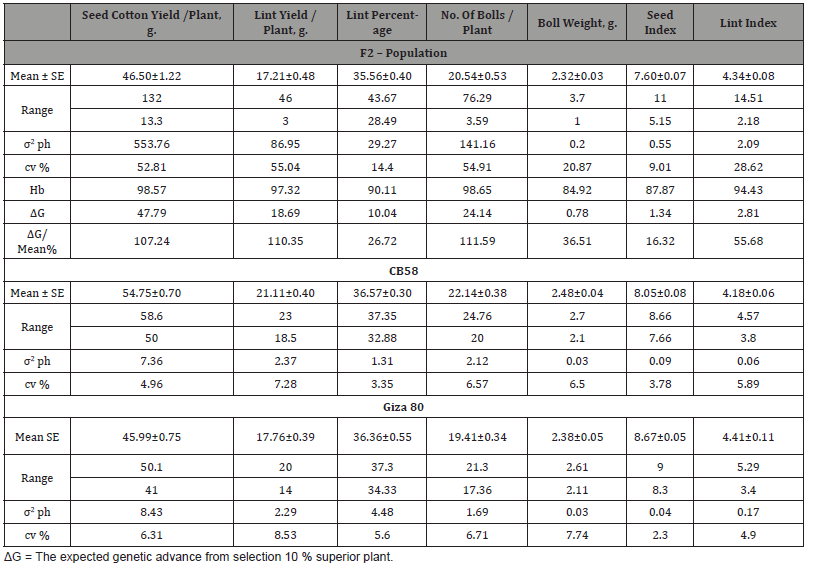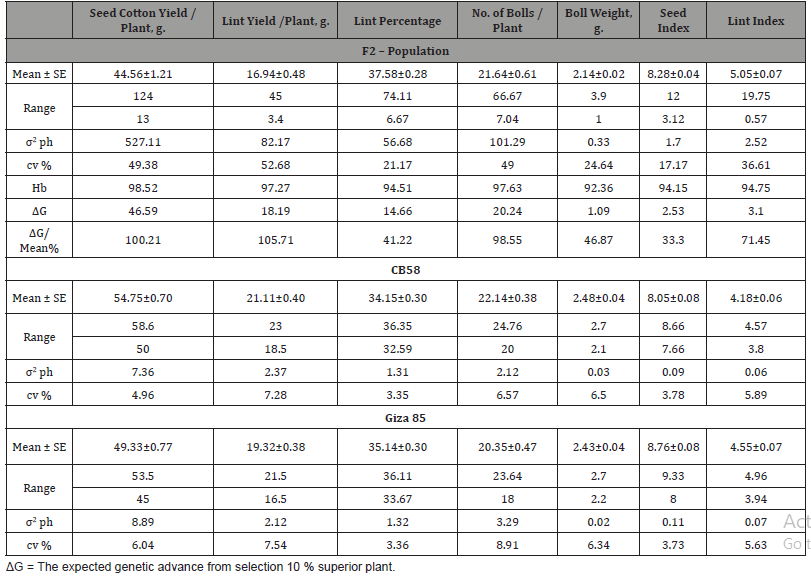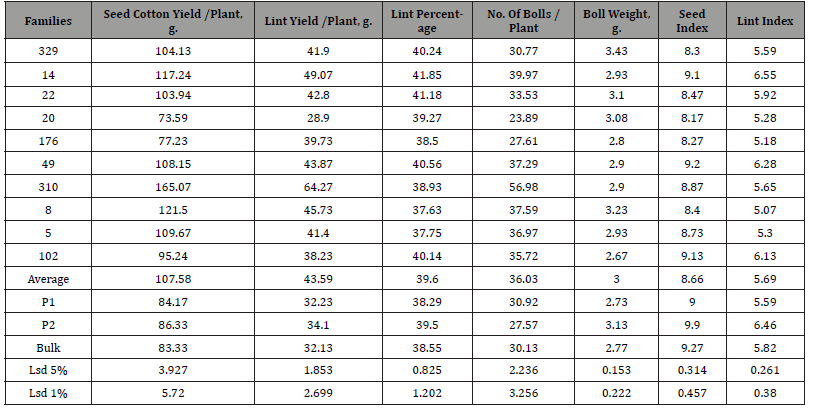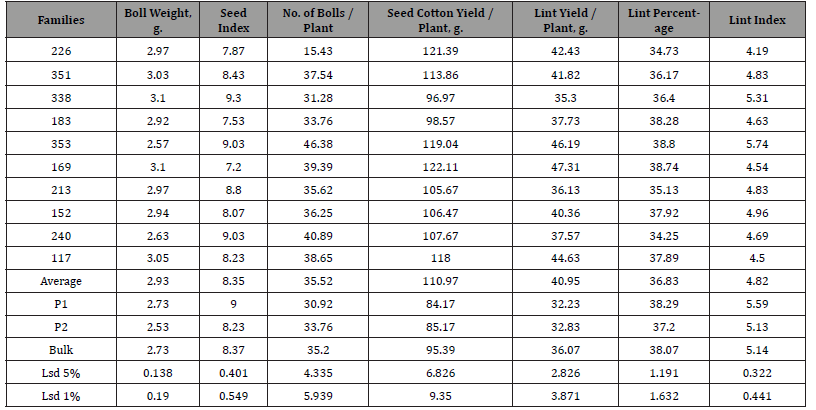 Research Article
Research Article
Pedigree Selection for Lint Yield in Two Segregation Populations of Egyptian Cotton (Gossypium barbadense L.)
JAbd El Sameea AA1*, Ibrahim MM2, MSH Ahmad2 and SA ELTahan1
1Cotton Research Institute, Agriculture Research Center, Giza, Egypt
22Department of Agronomy, Faculty of Agriculture Al-Azhar University, Assiut, Egypt
Abd El Sameea AA, Cotton Research Institute, Agriculture Research Center, Giza, Egypt.
Received Date: July 20, 2020; Published Date: August 11, 2020
Abstract
Two cycles of pedigree selection for lint yield/plant were achieved in two segregating populations of Egyptian cotton (Gossypium barbadense L.). the genetic materials were the F2, F3 and F4 generation of the cross C.B.58 × Giza 80 (pop. I) and C.B.58 × Giza 85 (pop. II) the phenotypic coefficient of variation (CV) of lint yield/plant was large enough in the F2 generation and accounted for 55.04 and 52.68 in pop I and pop II respectively. However; the CV% of the respective parents were very low reflecting their purity. Broad sense heritability of lint yield/plant was very high (0.97) for pop I and pop II, respectively. And unreliable in the F2 generation, which resulted in high expected genetic advance of 110.35 and 105.71% from the mean) for pop I and pop II, respectively. After Two cycles of selection, the retained genetic coefficient of variability was 34.00 and 13.75 for pop I and pop II, respectively. However, the realized heritability was 0.8665 and 0.3398 for pop 1 and 0.6552 and 0.4500 for pop II in cycle I and cycle 2, respectively. In pop I the direct observed gain was significant (p<0.01) from bulk sample (35.67%) and from the better parent (27.83%). Five superior families were isolated from pop 1 and significant exceeded the better parent and bulk sample in lint yield and correlated traits. in pop II, three superior families No.351, No 169 and No 353 showed significant gain in lint yield of 15.96, 31.17 and 28.07% from the bulk sample, and 27.38, 44.09 and 40.68% from the better parent; respectively. Family No.169, showed significant (p<0.01) correlated gain from better parent of 43.38,4.15, 27.39 and 22.37% for seed cotton yield/plant, lint percentage, number of bolls/plant and boll weight, respectively.
Keywords: Cotton; Selection; Lint cotton yield
Introduction
Cotton is the most important crop in the world. Cotton is still considered as an important crop in Egyptian Agriculture, although the decrease of its growing area and also, the decrease of its contribution in the national income. Great efforts were paid by the Egyptian cotton breeder to maintain its fiber quality traits and improve its yielding ability, also around the world. Plant breeders are continuously searching for a more effective and efficient selection methods. Although several selection methods were used for improving several traits in cotton yield, pedigree selection methods have become the most popular of plant breeding procedures. Most of Egyptian Cotton varieties were produced through this method by cotton Instituted center (C.I.C). younis [1] found that The phenotypic and genotypic coefficient of variability (PCV and GCV) decrease rapidly through two cycles of pedigree selection. Shaheen et al. [2] found high estimates of narrow sense heritability in F3 families.
Mohamed [3] found that sufficient genetic variability for further cycles of selection for seed cotton yield /plant. Khan et al [4] reported that broad sense heritability estimates 0.98 for seed cotton yield /plant, 0.96 for boll weight and 0.96 for number of bolls/ plants.
Yahia & Hassan [5] found that the phenotypic coefficient of variation values (PCV) were higher than genotypic coefficient of variation (GCV) for yield and its components.
Soliman [6] found that average observed genetic gain of 10 selected families after two cycles of pedigree selection for lint yield/ plant ranged from 9.08% (p< 0.01) for lint index 7 to 22.73% (p < 0.01) for index 2. Both of index 5 and index 8 raked the first and, showed significant genetic gain of (17.88 and 15.43%) in lint yield/ plant .The present work aimed to study the efficiency of pedigree selection for lint yield/plant to isolate superior families in yield and its components in two populations of Egyptian cotton.
Materials and Methods
The present study was carried out at (Dar El-Salam) Sohag Governorate during the three summer seasons of 2016 - 2018. The basic materials consisted of two F2-populations stemmed from crosses between three Egyptian cotton varieties (Gossypium barbadense L.). Population I (Pop I) stemmed from the cross (Giza80 x CB58) and population II (Pop II) from (Giza85 x C.B58), where the parent C.B.58 variety.
Was partner parent in two crosses in this study in season 2016 the two aforementioned populations in the F2 generation were sown on April in spaced plants, in rows 60 cm apart and 40 cm between hills within a row. After full emergence, three weeks after planting, the hills were thinned to one plant/hill. in the three seasons The recommend cultural practices for cotton production were adopted throughout the growing season. Data were recorded on 380 and 357 plants from pop I and II; respectively.
At the growing season, to picks were done on single plants. The recorded traits all seasons were; seed cotton yield/plant, lint percentage, number of bolls/plants, boll weight, seed index and lint index. The best 20 plant for lint yield/plant from each population of the two populations were saved. After ginning, five seeds from each of the 380 plants of pop. I, and from each of the 357 plants of pop. II were bulked to give an unselected bulk sample for each population. in season 2017; F3 generation the selected plants from pop1 and pop.11, along with respective, parent for each population and the unselected bulk sample were sown on April, in two separate experiments.
A randomized Complete Block Design of three replications was used. The plot size was one row, 4 m long, 60 cm apart and 50 cm between hills within a row. After full emergence, seedlings were thinned to one plant per hill. After the two picks, the best 10 plants from the best 20 families for lint yield/plant were saved from each population in season 2018 F4 generation, sowing date was April 2018. Experimental design and the plot size were as the previous season. Each experiment involved, the tow parents and the unselected bulk sample, Data were subject to proper statistical analysis according to steel & Torrie [7] Genotypes means were compared using revised least significant Different test (R L S D) according to EL-Rawi & Khalafalla [8]. The phenotypic (σ2P), genotypic (σ2g) variances, and heritability in broad sense(H) were calculated according to Walker [9].
Realized heritability (h2) was calculated as, h2= R/S Falconer [10], where, R= is response to selection and S= is selection differential. The phenotypic (PCV) and genotypic (GCV) coefficient of variability were calculated as outlined by Burton [11].
Description of the base population
The characteristics of the two base populations (Tables 1 &2) indicated sufficient coefficient variability in the criterion of selection, lint yield/plant in the population I (55.04%) and of pop II (52.68%). the coefficient variability (CV) of seed index and number of bolls/plants ranged from 9.01 to 54.91 % in pop .1, and from 17.17 to 49.00 % in pop.11, respectively.
Otherwise, the CV% of all traits of the three parents was very low, except for lint index (in two populations) reflecting the high purity of the parents. Broad sense heritability estimates were very high and exceeded 90 % for all traits in each two populations except boll weight and seed index in pop. I (Tables 1 & 2). In consequence, high and unreliable estimates of excepted gains in percentage of the F2-meen were obtained.
Table 1: Means, phenotypic variance (σ2 ph), heritability in broad sense (H) and expected genetic advance (ΔG) of the base population I (F2) and its parents of the studied traits season 2016.

Table 2: Means, phenotypic variance (σ2 ph), heritability in broadsense (H) and expected genetic advance (ΔG) of the base population II (F2) and its parents of the studied traits season 2016.

Pedigree selection for lint yield/plant
Variability and heritability estimates: Mean squares of the selection families for lint yield/plant and the other studied traits were significant (P<0.01) in both of pop I and pop II. After two cycles of Pedigree selection (Table 3&4) thegcv and pcv% were high in the two populations and accounted for 34.00 and 34.15% for pop I and 13. 75 and 14.41% for pop II, respectively, was indicating sufficient genetic variability for further cycles of selection for lint yield/plant.
Generally, the coefficients of variation (CV) for each of seed cotton yield /plant, lint yield/plant and number of bolls/plants were higher in popII than popI. The close estimates of pcv and gcv % resulted in very high estimates of broad sense heritability which reached 99.31 and 91.06 for pop. I and popII, respectively. This could be due to main causes the first one; evaluation of the selected families at one site for one season inflated the family’s mean squares by the confounding effects of the interactions among, years and location.
The second cause is the preponderance of dominance and over-dominance in the early segregating generations. However, the realized heritability for lint yield/plant was 0.86 and 0.33 for pop. I and 0.65 and 0.45 in pop. II for cycle 1 and cycle 2, respectively (Tables 3 & 4). The wide differences between broad sense and realized heritability estimates were interpreted before and reflect the effect of dominance and over-dominance in the early segregating generations. Mahdy [12,13] reported sufficient genetic variability in lint yield/plant, number of bolls/plant and lint/seed after two cycles of pedigree selection for lint yield/plant.
Mustafa et al. [14] they watched compared high GCV for lint yield/plant in two Trials. Shaheenet al. [2], Mahdy et al. [3,15], are in the same line with the results herein respect to heritability estimates and coefficient of variability. Haugerud & Contrell [16]. Reported that, the breeder concerned with performance of individual selected families this could be due to that the overall mean make the individual families mean. Falconer [10] stated that, selection reduces variance. Khan et al. [4] reported that broad sense heritability estimates of 0.98 for seed cotton yield/plant, 0.96 for boll weight and 0.96 for number of bolls/plants.
Means and observed gain
Means and direct observed gain for lint yield/plant. g: Mean lint yield/plant in pop. I after tow cycles of selection (Table 5) ranged from 28.90 to 64.27 with an average of 43.59 while it ranged from 35.3o to 47.31 with an average 4o.95 in pop. II (Table 6). However, sufficient genetic variability for further cycles of selection for lint yield/plant, where GCV % was 34.0 and 13.75 %for pop I and pop II, Respectively.
Table 3: Mean squares, broad sense heritability (H), and genotypic (GCV%), and phenotypic coefficients of variability (PCV%) of the selected families for Lint yield /plant, g. in population I; (season 2018).

Table 4: Mean squares, broad sense heritability (H), genotypic (GCV%), phenotypic coefficients of variability(PCV%) of the selected families for Lint yield /plant, gin population II; (season 2018)

Table 5: Means of the studied traits of the selected families for Lint yield /plant, g. in population I; (season 2018).

Table 6 Means of the studied traits of the selected families for Lint yield /plant, gin population II; (season 2018).

Table 7: Observed direct and correlated responses after the second cycle of pedigree selection of the selected families for Lint yield /plant, g measured in percentage of the unselected bulk in population I; (season 2018).

Table 8: Observed direct and correlated responses after the second cycle of pedigree selection of the selected families for Lint yield /plant, g measured in percentage of the unselected bulk in population II; (season 2018).

Table 9: Observed direct and correlated responses after the second cycle of pedigree selection of the selected families for Lint yield /plant, g. measured in percentage from the better parent in population I; (season 2018).

Table 10: Observed direct and correlated responses after the second cycle of pedigree selection of the selected families for Lint yield /plant, g measured in percentage from the better parent in population II; (season 2018).

The correlated gains in population I (C.B.58 x Giza 80): The average direct observed gain from the bulk sample was significant (p<0.01) in pop I and reached 35.67% (5.39% per cycle ) (Table7) nine selected families showed significant (p<0.01 - p<0.05 ) direct gain ranged 28.85 for family No. 5 to 100.o2 for family No. 310 (Table 7) The direct observed gain in lint yield/plant from the better parent ; Giza 80 (Table 8) ranged from 16.51 to 88.47% for families 176 and 310 ,respectively, with an average 27.83% . Nine selected families showed significant (p<0.01) direct gain from the better parent in pop I the most superior families in pop I were families, 329, 22, 49 and 310.
In pop II, eight selected families showed significant (p<0.01 - p<0.05) direct observed gain in lint yield/plant ranged from 4.16 to 31.17% for families 240 and 169, respectively. With an average of 13.53% from bulk sample (Table 9). Furthermore; all 10 selected families showed significant (P<0.01) direct gain from the better parent Giza 85, which ranged from 7.51 for family NO.338 to 44.09 % for family NO 169 with an average of 24.71% (Table 10). Mahdy [12,13] achieved observed gain in lint yield/plant after two cycles of selection in two population of 8.4 and 6.3% from the better parent. Mahdy et al. [17,18] reported that direct observed gain in lint yield/plant exceeded the med –parent by 32.88%. Mohamed [3], El-okkiah et al [19] and Soliman [6] are in agreement with These results Two cycles of pedigree selection for lint yield/plant in pop I accompanied with favorable significant (P<0.01) correlated gains from the bulk sample.29.10% for seed cotton yield /plant 19.59% for number of bolls/plant, 2.74% for lint percentage and 8.23% for boll weight (Table 9). Likewise, the correlated gain from the better parent (Table10) was significant (p<0.01) for seed cotton yield /plant (24.61) for number of bolls/plant (16.53% ), boll weight (-4.32) , seed index (-12.49%) and lint index (-11.90%) taking in to consideration The direct gain in lint yield/plant and the correlated gain in seed cotton yield /plant the four promising families were family No.329, No.22, No.49 and No.310.
It should be recall that eight of the 10 selected families for lint yield/plant were also promising for seed cotton yield /plant, and three out of four superior families (14,310 and 8) were superior for seed cotton yield /plant.
The correlated gains in population 11 (C.B.58 x Giza 85): selection for lint yield /plant , g, for tow cycles showed significant (p<0.01) increase in seed cotton yield /plant of 16.34 % and , boll weight of 7.11%% from the bulk sample , and decrease in lint percentage of -3.24% and lint index -6.21% (Table 9) The other correlated traits showed average insignificant correlated gains from the bulk sample. The average of the different traits masked the superiority of the individual selected families. Five of the 10 selected families were superior and showed highly significant correlated gains for seed cotton yield/plant, and boll weight. These superior families were families 226, 351,169, 152 and 117 (Table 9) The correlated gains in seed cotton yield/plant ranged from 3.33% and ranged in boll weight from 7.44% to 13.41% from the bulk sample. Furthermore, the aforementioned seven superior families showed significant (P<0.01) correlated gains from the better parent in seed cotton yield/plant, number of bolls/plant and boll weight (Table 10) The range of correlated gain was from 15.73% to 43.38% for seed cotton yield/plant, from 3.95% to 22.37% for boll weight and from 9.17% to 50.00% for number of bolls/plant. These results are in agreement with those reported by Mahdy et al. [7], Mahrous [20], Mahdy et al. [4], Abd El-salam et al [21], Yahia & Hassan [5] and Soliman [6] they found correlated gains in seed cotton yield/plant, boll weight, number of bolls/plant and seed index when selection for yield.
Acknowledgement
None.
Conflict of Interest
No conflict of interest.
References
- Younis FG (1986) Comparative studies on selection procedures in cotton. Ph.D. Thesis, Assiut Univ, Egypt.
- Shaheen AMA, MAM Gomaa, RM Esmail (2000) Response to selection for yield, yield components and fiber properties in three Egyptian cotton crosses. Ann Agric Sci Cairo.
- Mohamed AA (2001) Breeding for earliness and yield components in someEgyptian cotton crosses. Ph. D. thesis, Assiut Univ Egypt.
- Khan NU, G Hassan, IA Khan, W Ahmad (2009) Genetic variability and heritability in upland cotton. Pak J Bot 41: 1695-1705.
- Yehia WMB, SS Hassan (2015) Genetic analysis of yield and its component of some Egyptian cotton crosses (Gossypiumbarbadense L). Alex J Agric Res 60(3): 173-181.
- Soliman AM (2018) Efficiency of selection index in improvement yield and yield components in segregating population of Egyptian cotton Article 10, 1(1): 129-141.
- Steel RGD, JH Torrie (1960) Principles and Procedures of Statistics. McGraw Hill Book Company, Inc. New.
- El Rawi K, AM Khalafalla (1980) Design and Analysis of Agricultural Experiments, El Mousel Univ, Iraq, 19.
- Walker JT (1960) The use of a selection index technique in the analysis of progeny row data. Emp, Cott' Gr Rev' 37: 81-107.
- Falconer DS (1989) Introduction to Quantitative Genetics, 3rd Ed. Longman. John Wiley & Sons, New York.
- Burton GW (1952) Quantitative inheritance in grasses. 6th Internet Grassland Cong Proc 1: 227-238.
- Mahdy EE (1983b) Relative effectiveness of pedigree line and recurrent selection for improving lint yield in cotton (G. barbadenseL.). Assiut J of Agric Sci 14: 315-325.
- Mahdy EE (1983a) Selection index in cotton (G. barbadense L.) Assiut J of Agric Sci 14: 267-282.
- Mustafa FS, MM Awaad, SIS Abou-Zahra (1995) Evaluation of some strains of long stable cotton hybrids at different locations in Egypt in 1993 season: lint cotton yield and fiber properties. Proceedings Beltwide Cotton Conferences, San Antonio, TX, USA 7(1): 586-587.
- Mahdy EE, AA Ismail, HY Awad, AA Mohamed (2001a) The relative merits of breeding and modified recurrent selection in improving seed cotton yield in two segregating populations of Egyptian cotton (G barbadense L.). The 2nd Plant Breed Conf 61-79.
- Haugerud NG, Cantrell RG (1984) Selection for grain yield and nitrogen partitioning efficiency in hard red spring wheat. Cropci 22(3): 591-595.
- Mahdy EE, EA Hassaballa, MA Khalifa, FG Younis (1987a) Relative efficiency of three selection procedures in improving yield and its components in Egyptian cotton. Assiut J of Agric Sci 18: 159-175.
- Mahdy EE, EA Hassaballa, MA Khalifa, FG Younis (1987b) Comparative studies on three selection procedures in an interspecific population of cotton. Assiut J of Agric Sci 18: 179-195.
- EL-Okkiah AFH, MM Kassem, GA Sary, MM EL-Lawendey (2008) Improving lint yield and its components in early segregating generations of Giza 45 x Giza 75 cotton cross. Egypt J Agric Res 86: 631-641.
- Mahrous H (2008) Selection for earliness and lint yield in early and late plantings in some populations of Egyptian cotton. D. Thesis, Assiut Univ, Egypt.
- Abd-El-Salam ME, BM Ramadan, YM El Mansy (2013) Comparative study on the pedigree and recurrent selection in cotton breeding. Minufiya J Agric Res 6(2): 1447-1454.
-
Abd El Sameea AA, Ibrahim MM. Aquifer Vulnerability Using Geophysical and Physiochemical Methods in Parts Of Ethiope West Local Government Area Delta State, Nigeria. World J Agri & Soil Sci. 5(4): 2020. WJASS.MS.ID.000616.
-
Cotton, Selection, Lint cotton yield, Plants, Bolls/Plants, Boll weight, Yield
-

This work is licensed under a Creative Commons Attribution-NonCommercial 4.0 International License.






